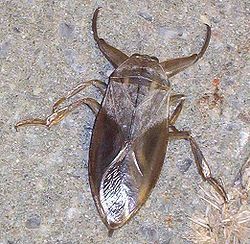
Lethocerus americanus
Encyclopedia
Lethocerus americanus is a giant water bug
in the family Belostomatidae, native to North America
. It was originally classified as a species in genus Belostoma.
 Commonly found in ponds, marshes and on the edges of lakes and slow moving streams, adults and larvae feed on other insects, small crustaceans (crabs/crayfish), tadpoles, snails and small fish. The adult swims with the aid of its hind legs. A pair of front forelimbs are used for capturing and latching onto its intended prey, which it then injects with digestive toxins through a somewhat retractable proboscus much like that of a mosquito. Lethocerus tends to let its prey pre-digest for 10–15 minutes before eating. Multiple L. americanus have been seen to hunt and then share the same prey animal. Underwater, the adult breathes air that it traps under its wings using two snorkel-like tubes that extend from the rear of its abdomen.
Commonly found in ponds, marshes and on the edges of lakes and slow moving streams, adults and larvae feed on other insects, small crustaceans (crabs/crayfish), tadpoles, snails and small fish. The adult swims with the aid of its hind legs. A pair of front forelimbs are used for capturing and latching onto its intended prey, which it then injects with digestive toxins through a somewhat retractable proboscus much like that of a mosquito. Lethocerus tends to let its prey pre-digest for 10–15 minutes before eating. Multiple L. americanus have been seen to hunt and then share the same prey animal. Underwater, the adult breathes air that it traps under its wings using two snorkel-like tubes that extend from the rear of its abdomen.
Commonly known as "toe biters", L. americanus may deliver a painful bite if handled or disturbed. However, they prefer to avoid humans rather than engage them whenever possible. If disturbed in the water, the speed of L. americanus allows it to quickly break away while its natural camoflauge easily conceals it. Even if agitated on dry land, the L. americanus will first attempt to escape or play dead before raising its forelimbs and hindquarters in what resembles a fighting stance. If agitation continues, L. americanus will use its forelimbs to latch onto the source of the agitation and attempt to deliver a painful bite. Also known as the "electric light bug", it may be attracted by electric lights while flying at night.
Eggs are laid on vegetation located at the water's edge and may be guarded by an adult. The young nymph
s then hatch about two weeks later.
Lethocerous makes a fascinating aquarium pet, creating little waste and prefering inherently to feed on small crustaceans and feeder shrimp rather than more valuable aquarium fare. However, when choosing to care for a Lethocerous/Lethoceri one must be sure that the aquarium lid is completely secure with no room for the insect to escape (as Lethocerous has the ability to fly).
Giant water bug
Belostomatidae is a family of insects in the order Hemiptera, known as giant water bugs or colloquially as toe-biters, electric-light bugs and Alligator Ticks . They are the largest insects in the order Hemiptera, and occur worldwide, with most of the species in North America, South America,...
in the family Belostomatidae, native to North America
North America
North America is a continent wholly within the Northern Hemisphere and almost wholly within the Western Hemisphere. It is also considered a northern subcontinent of the Americas...
. It was originally classified as a species in genus Belostoma.
Habits

Commonly known as "toe biters", L. americanus may deliver a painful bite if handled or disturbed. However, they prefer to avoid humans rather than engage them whenever possible. If disturbed in the water, the speed of L. americanus allows it to quickly break away while its natural camoflauge easily conceals it. Even if agitated on dry land, the L. americanus will first attempt to escape or play dead before raising its forelimbs and hindquarters in what resembles a fighting stance. If agitation continues, L. americanus will use its forelimbs to latch onto the source of the agitation and attempt to deliver a painful bite. Also known as the "electric light bug", it may be attracted by electric lights while flying at night.
Eggs are laid on vegetation located at the water's edge and may be guarded by an adult. The young nymph
Nymph (biology)
In biology, a nymph is the immature form of some invertebrates, particularly insects, which undergoes gradual metamorphosis before reaching its adult stage. Unlike a typical larva, a nymph's overall form already resembles that of the adult. In addition, while a nymph moults it never enters a...
s then hatch about two weeks later.
Lethocerous makes a fascinating aquarium pet, creating little waste and prefering inherently to feed on small crustaceans and feeder shrimp rather than more valuable aquarium fare. However, when choosing to care for a Lethocerous/Lethoceri one must be sure that the aquarium lid is completely secure with no room for the insect to escape (as Lethocerous has the ability to fly).

